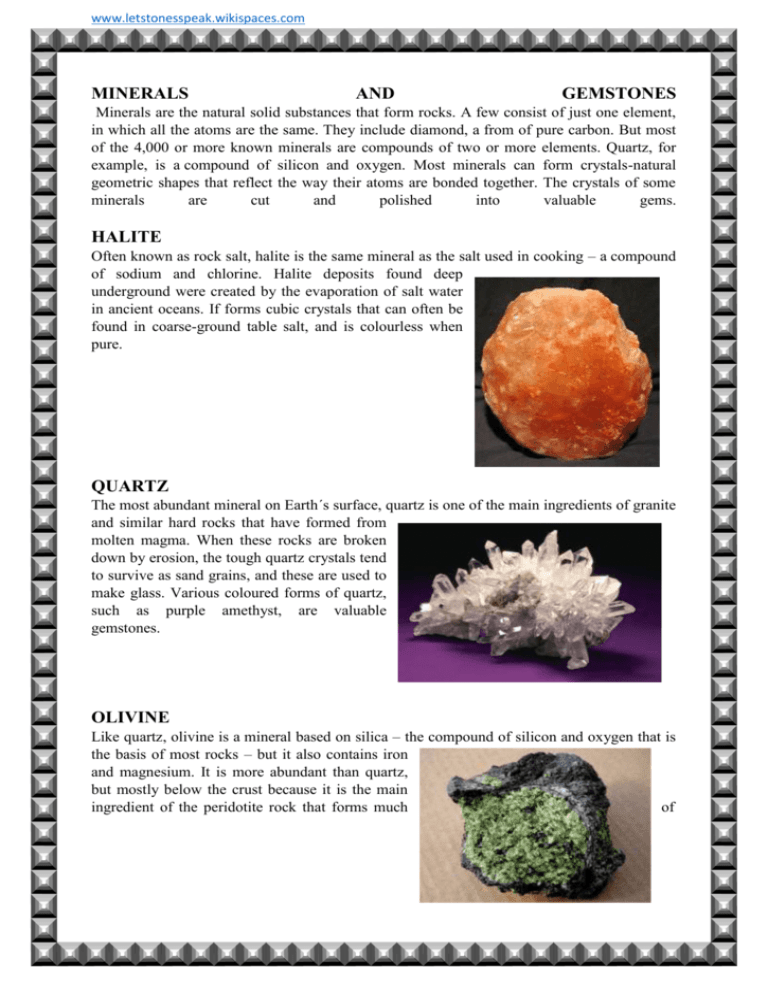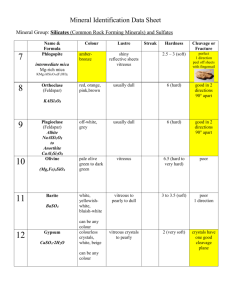MINERALS AND GEMSTONES - Letstonesspeak
advertisement

www.letstonesspeak.wikispaces.com MINERALS AND GEMSTONES Minerals are the natural solid substances that form rocks. A few consist of just one element, in which all the atoms are the same. They include diamond, a from of pure carbon. But most of the 4,000 or more known minerals are compounds of two or more elements. Quartz, for example, is a compound of silicon and oxygen. Most minerals can form crystals-natural geometric shapes that reflect the way their atoms are bonded together. The crystals of some minerals are cut and polished into valuable gems. HALITE Often known as rock salt, halite is the same mineral as the salt used in cooking – a compound of sodium and chlorine. Halite deposits found deep underground were created by the evaporation of salt water in ancient oceans. If forms cubic crystals that can often be found in coarse-ground table salt, and is colourless when pure. QUARTZ The most abundant mineral on Earth´s surface, quartz is one of the main ingredients of granite and similar hard rocks that have formed from molten magma. When these rocks are broken down by erosion, the tough quartz crystals tend to survive as sand grains, and these are used to make glass. Various coloured forms of quartz, such as purple amethyst, are valuable gemstones. OLIVINE Like quartz, olivine is a mineral based on silica – the compound of silicon and oxygen that is the basis of most rocks – but it also contains iron and magnesium. It is more abundant than quartz, but mostly below the crust because it is the main ingredient of the peridotite rock that forms much of www.letstonesspeak.wikispaces.com the planet´s DIAMOND deep mantle. Olivine AND crystals are usually green, as seen here. GRAPHITE Although they are both pure carbon, diamond and graphite are physically quite different. Diamond is the hardest of all minerals and a valuable the soft, streaky minerals used to is due to the way diamond has structure, while the atoms of layers. gemstones, while graphite is make pencils. The difference a very strong atomic graphite are arranged in SULPHUR Most frequently found as deposits around volcanic craters and hot springs, pure sulphur is a soft, usually bright yellow mineral. It consists of just one type of atom, but it combines with other elements such as iron and oxygen to form compounds such as pyrite and sulphur dioxide. It is an important ingredient of many artificial chemicals. CALCITE Another of the most common minerals, calcite is the main ingredient of limestones. These are usually formed from the shells or skeletons of marine organisms, which absorb the mineral from seawater. Calcite is easily dissolved by slightly acidic rainwater, but recrystallizes in a variety of forms. BERYL The main source of berylium, one of the lightest metals, beryl is better known for its big prismatic crystals. These are cut into gemstones that have different names depending on their colour, such as www.letstonesspeak.wikispaces.com deep green emerald and pale blue-green aquamarine. Some beryl crystals are very big – an aquamarine found in Brazil 1910 weighed 110,5 kg (243 lb). in ZIRCON Similar to diamonds and often used as gemstones, zircon crystals are extremely hard and resistant to erosion. As a result, they survive when other minerals are destroyed. Some Australian zircon crystals have been radiometrically dated to 4,2 billion years ago, which is almost as old as Earth and older than any other known substance on the planet. PYROXENE One of the most important rock-forming minerals, pyroxene is a major ingredient of ocean-floor rocks such as basalt. It can contain a variety of metallic elements such as iron, magnesium, or titanium, but always in combination with silicon and oxygen. One form, jadeite, is very strong and was once used to make polished axe blades. FELDSPAR Big, colourful feldspar crystals are a conspicuous part of many types of granite, and can often be seen in the polished granite slabs used in architecture. The crystals often show a feature called twinning, where the crystal structure is symmetrical with a clear centreline. Feldspar can contain a variety of elements depending on how it formed, but it always contains aluminium and silicon. MICA A major ingredient of granite and similar rocks, mica has an unusually complex chemical make-up and forms strange flat, flaky crystals with six sides. These can be astonishingly big – one crystal found in eastern Russia had an area of 5 sq m (54 sq ft). Mica has a high melting point, and thin, transparent sheets of it are sometimes used as furnace windows. TLAC The softest mineral, easily scratched by a fingernail, talc is sometimes known as soapstone because of its soapy feel. It is used for decorative carvings and ground into talcum powder, www.letstonesspeak.wikispaces.com but its main use is in the manufacture of heat-resistant ceramics such as cookware, and in papermaking.










